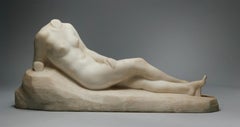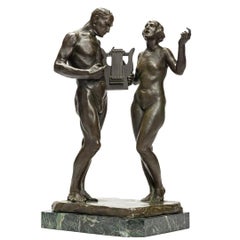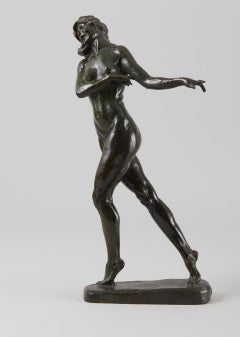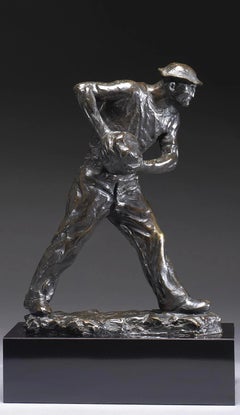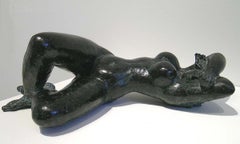Max Kalish Nude Sculptures
American, Lithuanian, 1891-1945
Born in Poland March 1, 1891, figurative sculptor Max Kalish came to the United States in 1894, his family settling in Ohio. A talented youth, Kalish enrolled at the Cleveland Institute of Art as a fifteen-year-old, receiving a first-place award for modeling the figure during studies with Herman Matzen. Kalish went to New York City following graduation, studying with Isidore Konti and Herbert Adams for the next two years.
In 1912, Kalish studied with Paul Bartlett at the Academie Colarossi in Paris, France. In 1913, he continued his studies with Jean Antoine Injalbert at the Ecole des Beaux-Arts. The financial support of his brother, family and friends had enabled Kalish to travel to Europe. But the money ran out and, though Kalish exhibited two portrait busts in the 1913 Paris Salon, he was forced to return to America, where he worked on the Column of Progress for the 1915 Panama-Pacific Exposition, in San Francisco, California, with his former teacher, Isidore Konti.
Back in Cleveland, he worked on portrait commissions of two United States Senators and the Mayor. In the Army by 1916, Kalish sculpted a series of bronze, one-third-life-size figures of solders. In 1920, he was back in Paris, where he would begin a life-long practice of spending half the year. In 1921, he sculpted his first laborer, “The Stoker”, a genre for which he would be best known, using as a model, a Cleveland blast furnace worker. In Paris in 1922, the sculptures of laborers by Belgian artist Constantine Meunier (1831-1905) cemented Kalish’s desire to sculpt workers. Kalish won first prize for four sculptures three laborers — in 1925 at the Cleveland Artists and Craftsmen exhibition, one of which a marble nude torso was acquired by the Cleveland Museum of Art. This prize and purchase accelerated Kalish’s career. In 1928, he received a commission from the City of Cleveland for a twelve-foot-high bronze sculpture of Abraham Lincoln delivering the Gettysburg Address. It stands today in front of the west entrance of the Board of Education on East 6th Street.
Living and working in New York City in 1932, he was elected an Associate of the National Academy of Design in 1933. He later became a member of the National Sculpture Society. At the outset of World War II, Kalish was commissioned by the Museum of American History to sculpt forty-eight bronze figures — one-third-life-size — of those involved in the war effort, including President Roosevelt, his cabinet and other important people. He lived to see the work completed, though afflicted by cancer from which he died on March 18, 1945 in New York City. The sculpture of Max Kalish was included in the 1997 exhibition in Berkeley, California, “When Artists Became Workers: The People’s Art Movement of the ’30s and ’40s”, at the Judah L. Magnes Museum.to
3
1
Overall Width
to
Overall Height
to
4
1
2
2
4
3
2
2
1
1
1
3
3
2
2
7
86
31
25
24
4
Artist: Max Kalish
20th Century Reclining Female Nude Marble Sculpture, Cleveland School Artist
By Max Kalish
Located in Beachwood, OH
Max Kalish (American, 1891-1945)
Reclining Nude
Marble
Signed on base
9 x 20.5 inches
Born in Poland March 1, 1891, figurative sculptor Max Kalish came to the United States in 1894,...
Category
Mid-20th Century Max Kalish Nude Sculptures
Materials
Marble
Harmony, 20th century bronze & green marble base, nude man and woman with lyre
By Max Kalish
Located in Beachwood, OH
Max Kalish (American, 1891-1945)
Harmony, c. 1930
Bronze with green marble base
Incised signature on right upper side of base
14 x 9 x 5 inches, excluding base
17 x 10 x 8 inches, including base
Born in Poland March 1, 1891, figurative sculptor Max Kalish came to the United States in 1894, his family settling in Ohio. A talented youth, Kalish enrolled at the Cleveland Institute of Art as a fifteen-year-old, receiving a first-place award for modeling the figure during studies with Herman Matzen. Kalish went to New York City following graduation, studying with Isidore Konti...
Category
1930s American Modern Max Kalish Nude Sculptures
Materials
Marble, Bronze
Nude Walking, Early 20th Century Bronze Sculpture, Cleveland School Artist
By Max Kalish
Located in Beachwood, OH
Max Kalish (American, 1891-1945)
Nude Walking, 1930
Bronze
Signed and dated on base
17 x 9 x 4 inches
Born in Poland March 1, 1891, figurative sculptor Max Kalish came to the United States in 1894, his family settling in Ohio. A talented youth, Kalish enrolled at the Cleveland Institute of Art as a fifteen-year-old, receiving a first-place award for modeling the figure during studies with Herman Matzen. Kalish went to New York City following graduation, studying with Isidore Konti and Herbert Adams...
Category
1930s American Modern Max Kalish Nude Sculptures
Materials
Bronze
"Road Builder" 20th Century Modern WPA Labor Bronze WPA Depression-Era Sculpture
By Max Kalish
Located in New York, NY
Max Kalish
The Road Builder
inscribed M. KALISH 23, with Meroni-Radice foundry mark, on top of base bronze with dark brown patina, on an ebonized rectangular plinth
Height: 13 1/8 in. not including base
Provenance: Spanierman Gallery, New York
BIO
Max Kalish (1891 – 1945)
Born in Poland March 1, 1891, figurative sculptor Max Kalish came to the United States in 1894, his family settling in Ohio. A talented youth, Kalish enrolled at the Cleveland Institute of Art as a fifteen-year-old, receiving a first-place award for modeling the figure during studies with Herman Matzen. Kalish went to New York City following graduation, studying with Isidore Konti and Herbert Adams...
Category
1920s American Realist Max Kalish Nude Sculptures
Materials
Bronze
Related Items
The Comedy
Located in PARIS, FR
Pierre-Marie POISSON (1876-1953)
The Comedy
Bronze sculpture with black patina
signed on the base "P. Poisson"
Cast by Valsuani (with the foundry stamp)
Raised on a stone base
Fra...
Category
1930s French School Max Kalish Nude Sculptures
Materials
Bronze
RECLINGING WOMAN
By Antoniucci Volti
Located in Los Angeles, CA
ANTONIUCCI VOLTI
"RECLINGING WOMAN"
BRONZE, SIGNED, NUMBERED 2/6
VALSUANI FOUNDRY
ITALiAN, WORKED IN PARIS, C.1960
6.5 X 18.5 X 10.5 INCHES
Antoniucci Volti
1915-1989
Sculptor, painter, and printmaker Antoniucci Volti was born in Albano, Italy, in 1915. His family lived in Italy until 1920 when the family moved to France.
Volti studied at the Ecole des Arts Décoratifs in Nice from 1928 to 1920. By 1932 the young artist had won a gold medal for two polychrome bas-reliefs before going to Paris, where he entered the studio of Jean Boucher at the Ecole Nationale des Beaux-Arts in Paris at the age of only fifteen.
After serving in the Second World War, when he was interned as a prisoner of war in Bavaria, he returned in poor health to Paris, only to find his studio destroyed.
From 1947 he showed work at various Paris Salons and, in 1954 and 1955 at the Brussels and Antwerp Biennales. In 1957 a retrospective of his work was organized at the Museum Rodin in Paris.
He died in Paris in 1989 Works by Volti are in leading museums such as the Musée National d'Art Moderne, Paris. Antoniucci Volti is one of the most important Late Modern...
Category
1960s Modern Max Kalish Nude Sculptures
Materials
Bronze
"Pioneer Family" WPA American Modernism Plaster Maquette Realism 20th Century
By William Zorach
Located in New York, NY
"Pioneer Family," 23 1/2 x 16 1/4 x 10 3/4 inPlaster. c. 1927. Unsigned. Realism
The Smithsonian has a cast of this sculpture in its collection. Pictured on the cover of “The Sculpt...
Category
1920s American Modern Max Kalish Nude Sculptures
Materials
Plaster
$39,000
H 24 in W 17 in D 11 in
1961 Coty Award Plaque Kenneth Hairdresser Jacqueline Onassis Bronze Fashion
Located in New York, NY
1961 Coty Award Plaque Kenneth Hairdresser Jacqueline Onassis Bronze Fashion
Bronze on wood. The wood plaque measures 12 3/4" by 20 3/4 inches. The bronze plaque itself is 13 3/4 x 8 3/4 inches and the the bronze inscription, which reads "COTY, American Fashion Critics Special Award 1961 to KENNETH of LILY DACHE...
Category
1960s American Modern Max Kalish Nude Sculptures
Materials
Bronze
Woman Seated A Bronze Sculpture of a Woman by Charles Rumsey
By Charles Cary Rumsey
Located in Brookville, NY
The bronze sculpture of a woman by Charles Rumsey is undated, but was created at a point in his career where he began to transition from realism to more modern, looser depictions of ...
Category
1920s American Modern Max Kalish Nude Sculptures
Materials
Bronze
$6,000
H 10.5 in W 11 in D 6 in
Aquila Bronze Sculpture Nude Boy Marble Stone Contemporary In Stock
By Wim van der Kant
Located in Utrecht, NL
Aquila Bronze Sculpture Nude Boy Marble Stone Contemporary In Stock - Sculpture without Stone is 57 cm high
Wim van der Kant (1949, Kampen) is a selftaught a...
Category
21st Century and Contemporary Contemporary Max Kalish Nude Sculptures
Materials
Marble, Bronze
$17,030
H 27.56 in W 7.88 in D 7.88 in
Crepis Bronze Sculpture Nude Boy Male Figure Marble Stone
By Wim van der Kant
Located in Utrecht, NL
Crepis Bronze Sculpture Nude Boy Male Figure Marble Stone
Wim van der Kant (1949, Kampen) is a selftaught artist. Next to his busy profession as a teacher at...
Category
21st Century and Contemporary Contemporary Max Kalish Nude Sculptures
Materials
Marble, Bronze
$16,525
H 17.72 in W 7.88 in
Aestus Bronze Sculpture Marble Stone Nude Boy Contemporary
By Wim van der Kant
Located in Utrecht, NL
Aestus Bronze Sculpture Marble Stone Nude Boy Contemporary
Wim van der Kant (1949, Kampen) is a selftaught artist. Next to his busy profession as a teacher ...
Category
21st Century and Contemporary Contemporary Max Kalish Nude Sculptures
Materials
Marble, Bronze
$18,234
H 20.87 in W 3.94 in
Ausum Bronze Contemporary Sculpture Marble Stone Nude Boy Male Figure
By Wim van der Kant
Located in Utrecht, NL
Ausum Bronze Contemporary Sculpture Marble Stone Nude Boy Male Figure
Wim van der Kant (1949, Kampen) is a selftaught artist. Next to his busy profession as a teacher at a high scho...
Category
21st Century and Contemporary Contemporary Max Kalish Nude Sculptures
Materials
Marble, Bronze
$9,269
H 16.15 in W 15.75 in
A French 19th Century Carved Marble Whimsical Figural Urn Fountain with Children
Located in LA, CA
A very fine large, rare and charming, French, 19th century. Belle Époque carved white marble whimsical figural urn fountain depicting children climbing on an urn with flowers and gar...
Category
Late 19th Century Academic Max Kalish Nude Sculptures
Materials
Marble
$125,000
H 55 in W 37 in D 30 in
Aquila- 21st Century Contemporary Bronze Realistic Sculpture of a Nude Boy
By Wim van der Kant
Located in Nuenen, Noord Brabant
Aquila
Bronze Sculpture on pedestal of marble
Hight bronze 57 cm with pedestal of marble (included) 68 cm
Wim van der Kant's sculptures are in bronze...
Category
2010s Contemporary Max Kalish Nude Sculptures
Materials
Marble, Bronze
$16,557
H 22.45 in W 8.27 in D 7.09 in
Italian 19th Century Carrara Marble Sculpture " Young Beauty Going for a Swim"
By Emilio Fiaschi
Located in LA, CA
A very fine Italian 19th century Carrara marble sculpture depicting a young beauty going for a Swim standing on the steps of a dock, raised on its original carved green marble pedest...
Category
Late 19th Century Academic Max Kalish Nude Sculptures
Materials
Marble
$125,000
H 77.25 in W 30 in D 30 in
Max Kalish nude sculptures for sale on 1stDibs.
Find a wide variety of authentic Max Kalish nude sculptures available for sale on 1stDibs. You can also browse by medium to find art by Max Kalish in bronze, metal, marble and more. Much of the original work by this artist or collective was created during the 20th century and is mostly associated with the modern style. Not every interior allows for large Max Kalish nude sculptures, so small editions measuring 8 inches across are available. Customers who are interested in this artist might also find the work of Benson Landes, and John W. Mills. Max Kalish nude sculptures prices can differ depending upon medium, time period and other attributes. On 1stDibs, the price for these items starts at $10,450 and tops out at $36,000, while the average work can sell for $23,225.
